At best, National Harbor is equivalent to a shopping mall
So the claims about the inspiration behind its design being Las Ramblas in Barcelona seem a bit specious.
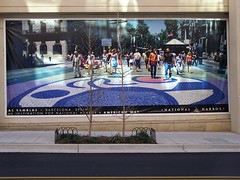
Large storefront sized banners are displayed on storefronts that haven't yet been leased out at National Harbor. This one compares National Harbor to Las Ramblas in Barcelona.
Finally went to National Harbor yesterday. Granted, in the winter there are many fewer people walking around, they aren't on the water so much, and there are few outdoor special events. (Although I imagine it was hopping during the special ice exhibit; "'Ice!' exhibit at National Harbor" from the Post.)
But it felt uncomfortable. Very little there isn't processed--chain restaurants, chain retail, and corporate stores like Peeps. And I can't imagine that any of the art galleries sell much art.
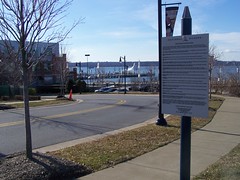
Make sure you follow the rules when you're at National Harbor. (Although to be fair, comparable rules are in place at shopping centers too.)
Afterwards we went to Alexandria, and the contrast was striking. Alexandria is far more interesting. Interestingly, because National Harbor is close to Alexandria and relatively "far" from the core of Washington, the information displays for tourist information, at least in the hotel, are the same ones used in Alexandria, and for the most part, feature attractions in that city, not DC.
National Harbor, which is marketed as being "Washington, DC" has absolutely nothing related to DC, other than the Potomac River location and the old Awakening sculpture that was at Hains Point. Eventually, it will have DC's Children's Museum too--the museum, after having received tens of millions of dollars of support from DC Government, decamped a few years ago.
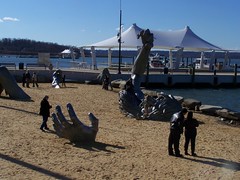
The Awakening sculpture on the Potomac River at National Harbor.
I did like how the parking meters (the complex has tons of parking structures, a couple hotels, and a time share "resort" building) have credit card readers built in.
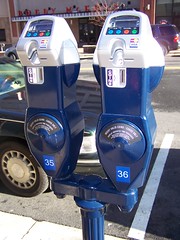
The commodification and reworking of the normal "National Experience" obtained by visiting to "Washington, DC" to better understand American Government, to instead promote the base sale of goods and service as "celebrating freedom" is pathetic but hardly surprising.
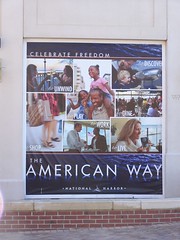
A banner promoting consumerism as the high point of "the American Way." American Way is also the name of "the main street" in the complex.
This visit reinforced my earlier statements that Disney, opening a resort hotel at National Harbor, is doing no favors to DC (despite claims to the contrary by DC tourism officials). It's strictly a move to capture a share of the money people would normally spend traveling to and visiting DC.
Like how the Gaylord Convention Center cross markets the National Harbor property to convention clients that have stayed in their other properties such as in Nashville, like Disney will heavily market their "Prince George's shopping mall is really Washington, DC" location to customers who have visited their other properties, to divert these clients from staying in competitor locations, and spending their money at places like Marriott-branded hotels instead of lining the Disney pockets.
------------
The Las Ramblas comparison is "funny" because that place as an inspiration for National Harbor was suggested in a column in the Washington Post in 2005. The column inspired the following entry: (Why aren't people) Learning from Jane Jacobs, and later this one as a follow up: (Why aren't people) Learning from Jane Jacobs revisited.
This is a reprint of the first entry------------------------------
Michele Dyson is a (once or twice monthly) columnist for the Washington Post, writing about Maryland issues for the back page of the Outlook section. Last Sunday's paper had the column "National Harbor: Think Small to Make It Special," about the gargantuan development coming to Prince George's County along the Potomac River. From her piece:
National Harbor is the largest private investment in the history of Maryland. In essence, it's a $2 billion wager that carries enormous risk. Much of the county's economic future is at stake, along with Peterson's reputation and money. Peterson has said that National Harbor will be his version of Las Ramblas, the grand pedestrian walkway near Barcelona's port district. But Barcelona is Spain's second-largest city. It hosted the 1992 Olympics, and its port is one of the most important in Europe. Along Las Ramblas, a visitor encounters artists, a huge opera house, fabulous food, a red-light district and an open-air pet market. Does this sound like Prince George's County? (...)
Peterson built projects all over the region, but mostly in Northern Virginia. His office park, residential and mixed-use projects have been standard suburban fare -- office buildings off major highways, apartments, condos, townhouses, single-family homes and maybe a church or two. His big-box stores, gas stations and chain restaurants have come accompanied by the inevitable giant slap of a parking lot.
Peterson has built a lot of these cookie-cutter developments, and not much distinguishes one from another. That is until recently. Peterson's work in the revitalized area of downtown Silver Spring has residents and businesses speaking in glowing terms.(**) And his National Harbor model gives reassuring evidence that the prime riverfront property just might be in the right hands. The elaborate 8-by-10-foot model generates excitement.
But if National Harbor is to become a favored destination, like San Francisco's North Beach or Miami Beach's South Beach, it will have to generate a large base of loyal local regulars. It also will need out-of towners who are willing to make a special trip there. People make special trips because they enjoy the ambience and unique qualities of an area. Toward that end, National Harbor should forgo strip mall cuisine. If we are what we eat, National Harbor will be what it serves. Forget Starbucks and ESPN Zone, and think San Francisco's Cafe Trieste and our own Vienna Inn.
Neighborhood vitality and verve can be as long-lived as New York's Greenwich Village or as newly minted as Richmond's Carytown. These places flourish because their status as celebrated destinations helps recruit artisans, artists and small businesses. These in turn plant roots, take risks and build the kinds of enterprises that further enrich the physical setting. National Harbor can do no less. Chain stores won't fill its streets, but an outstanding assortment of accomplished small businesses might.
______
** (Actually I think that the "revitalization" of Silver Spring is no different from traditional urban renewal. It's not pedestrian friendly, and small businesses are losing out, so much so that Montgomery County is suggesting that additional incentives be provided to small businesses to preserve them.)

Carytown photo by Steve Pinkus.
Like Ms. Dyson, I like Greenwich Village and Carytown in Richmond. In fact, Carytown is one of the more interesting commercial districts in the region--one that I've written about before. Yesterday's Richmond Times-Dispatch happened to have an interesting article on Carytown, entitled "Carytown: Where Change is Constant," about the ebb and flow of the retail businesses there.
And it included an incredibly important statistic--the average retail rent/square foot--In 1990, Carytown commercial rent was $10 a square foot. It's now about $18 to $20 a square foot.
National Harbor will be all new construction, meaning that prevailing rents will need to be a minimum of $60/sq. ft., and probably much higher (upwards of $120/sq. ft.). This makes it almost impossible to attract small businesses without serious subsidy.
One of the particularly grotesque aspects of the Inner Harbor in Baltimore is how, other than a couple local seafood restaurants like Phillips, it is now all chains--from ESPN Zone to California Pizza Kitchen. National chains, attracted by the large number of people-customers, have crowded out local businesses.
Sure the U.S.S. Constitution offers authenticity, but the Inner Harbor is for and about tourists, with little in the way of other authentic experiences.
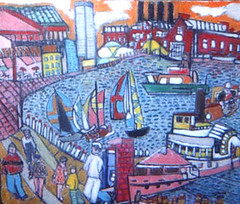
Would that Inner Harbor really looked like this. Title: Inner Harbor Media: Oil on Canvas, 1998. Size: 25" x 30, not framed. By Sy Mohr.
The rent statistic is interesting in another way. Even in "marginal" commercial districts in DC, such as H Street or Brookland, the floor of asking prices for rent is probably greater than $20/sq. ft. And these are for commercial districts far less successful than Carytown. This is why we need to be much more purposive in developing and incubating independent businesses.
One of the four rostrums from Jane Jacob's Death and Life of Great American Cities is the need for "a large stock of old buildings." This isn't because she is a preservationist, but because old buildings have lower carrying costs, particularly debt service, and this allows for the incubation of new businesses--retail, office, and other (it's part of the Richard Florida equation supporting the development of creative businesses).
This gets back to the point I make over and over again--the rule of thumb from the Main Street Approach is that a retail business pays 4%-10% of its annual revenues in rent (restaurants can and do pay slightly more). Figure it out backwards from what businesses can reasonably generate in revenues... yet the asking price for commercial buildings, asking prices for rent, and often the property tax assessments are completely out of whack compared to the revenue stream that successful businesses are likely to be able to generate.
This is why salon shops are dominant in many of the neighborhood commercial district, because they have a customer base that returns again and again, and the average transaction is high (a woman can easily spend $50-$150 getting her hair done) in comparison to the average retail business.
I agree that many of the retail businesses in our commercial districts are marginal, but they need help both to improve to be able to sell more, and the commercial districts need to improve more as well, in order to be able to draw greater numbers of patrons.
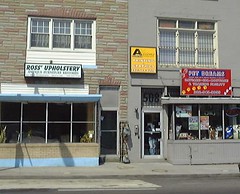
The place next store is available for rent! 500 block of H Street. Photo by Michael Berman.
Las Ramblas is a real city built up over centuries. When you build a development all at once, you can't have the ebb and flow of innovation, because high rents are the one uniform condition of such development.
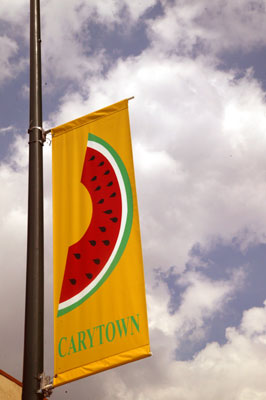
The Carytown Watermelon Festival is a big street festival involving many of the merchants on the street. It's scheduled for Sunday August 10th.
Speaking of rents, last Wednesday's New York Times had an article, "Columbus Ave. Distances Itself From Broadway," comparing Columbus Avenue to Broadway, and how "more personal unique" chains are locating on Columbus vs. the big chains (Barnes and Noble, etc.) on Broadway. The retail rents on Columbus Avenue average $180/sq. foot. That means that for a 2,000 sf. space, the store needs to generate at least $3.6 million in annual sales...
[Added 7/2008, also see the New York Times article, "Offering Big Spaces, Amsterdam Avenue Is Catching More Retailers."]
------------
In order to ensure some taste of the center city, National Harbor ought to build and install a model of Washington, DC or some of the monuments and attractions and put it in a window for people to gawk at, just as people were gawking at the model of National Harbor installed in a vacant storefront window on "Fleet Street."
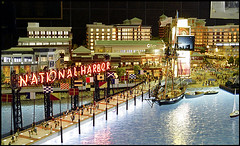
Photo: Preston Keres/The Washington Post. County unveils a $400,000 model of what the National Harbor project will look like.
Labels: commodification and exchange, commodification of the public space, public space management, urban design/placemaking, urban renewal



0 Comments:
Post a Comment
<< Home